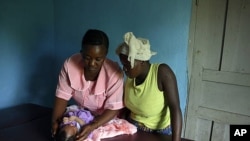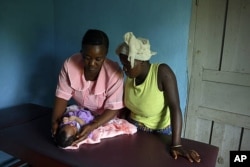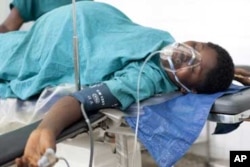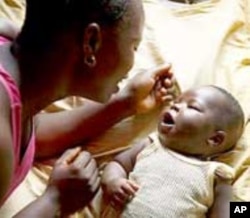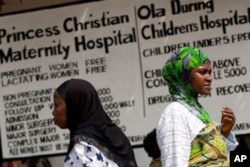Expectant mother Kudiratu Bangora was in trouble.
“I started bleeding and was rushed to the hospital,” she says.
Luckily, it was the best known emergency referral center in the country for pregnant women, the Princess Christian Maternity Hospital (PCMH) in the East End neighborhood of Sierra Leone’s capital, Freetown. Kudiratu’s baby was a breech birth, delivered by caesarian section immediately upon her arrival at the emergency room.
Many women are not so lucky.
About one in eight women in Sierra Leone die during pregnancy or childbirth, compared to one in 8,000 in developed countries, according to Amnesty International.
The road to good health
Sometimes in Sierra Leone, it is all but impossible to get from a village to a facility that can provide the care required for complicated births. Often, roads from rural areas are poor, and the family must pay for the taxi trip.
Amnesty International says costs can be three times as high at night, when it’s harder to find transportation. Last year, Amnesty released a report called Out of Reach: The Cost of Maternal Health in Sierra Leone. It says if a woman arrives at night, there are fewer staff members on duty and doctors often charge higher fees.
There are also not enough clinics that treat pregnant women. Amnesty says a 2008 needs assessment of maternal health in Sierra Leone found that emergency obstetric support was available in only 14 of the country’s 38 hospitals that provide maternal health care. It also found that six of the country’s 13 districts did not have emergency obstetric facilities.
Drugs and equipment in short supply
Many clinics have trouble getting the medications they need for emergency procedures, including childbirth.
Dr. Ibrahim Thorlie, a consultant in Obstetrics and Gynecology at the Princess Christian Maternity Hospital (PCMH) says he’s doing the best he can to help pregnant women in a country with what the UN Childrens’ Fund (UNICEF) says is one of the highest maternal mortality rates in the world.
Doctors operating at hospitals and clinics face shortages. Power fails and operating rooms go dark. A lack of clean water means instruments cannot be sterilized.
A maternal and child health aide, left, examines a newborn baby at a clinic in Pendembu, Kailahun district, Sierra Leone.
“We do not have all the drugs that we need,” adds Thorlie. “I was talking with the anesthesiologists, [who said] they don’t have anesthetics [while surgeons said] some of the sutures are not [appropriate] for caesarean sections.”
Most of the deaths at the clinic, he says, are due to blood loss from hemorrhaging during delivery. “Our greatest problem is the blood transfusion system. We need to make sure that we have a blood bank.”
Amnesty International says the problem is not specific to Freetown. Sierra Leone does not have a national blood bank system, which would be used in obstetric emergencies and to alleviate anemia caused by malnutrition in pregnant mothers and children. Amnesty says relatives are asked to donate blood, but many do not “in part because of widely held misconceptions that it is dangerous to do so.”
Peter Sikana is a reproductive and emergency obstetric care technical advisor at the UN Population Fund in Freetown who has worked at Princess Christian Maternity Hospital and other clinics around the country.
“I went in a district [where] there was not adequate anesthesia so we just used a light anesthesia, Ketamine, so the patient [was] half asleep, half awake. It is a difficult situation to perform a caesarian section when someone is half awake. Also, if you don’t have adequate electricity you have to use torches [flash lights] to operate. These are things you don’t expect to happen. These are tragic situations but I have experienced them.”
Retaining staff
These organizations say the lack of emergency care is worsened by the “brain drain,” caused by the departure of doctors and other skilled health care workers who get better paying jobs abroad. The World Health Organization reported in 2006 that Sierra Leone is one of 36 sub-Saharan Africa countries with fewer than 10 doctors for every 100,000 people.
The study found more Sierra Leonean doctors living in and around the U.S. city of Chicago than in their home country and suggests that higher salaries for doctors and improved government support for health care could help turn around Sierra Leone’s maternal health crisis.
Health advocates say medical training in Sierra Leone still has a long way to go.
Improvements underway
But there’s hope.
Dr. Sikana says each of Sierra Leone’s 13 districts has about 80 Primary Health Care Units [PHU], and the plan is to have some of them specialize in emergency obstetric care.
“We have over 1,020 PHUs throughout the country but not all of them conduct deliveries. The current plan is that every district should have five basic emergency obstetric care units at the PHU level. Once we have five basic obstetric care units, we can then increase the number to meet the UN recommendation of one comprehensive obstetric care unit and 5 basic obstetric care units for a population of 500,000.”
The question, he says, is staffing. He says many hospital maternity wards rely at night on the services of nursing aids and volunteers with no skills in delivering babies.
“It’s difficult to have doctors and midwives available 24 hours a day, so when these women [needing emergency obstetric care] arrive, interventions are performed immediately. And that’s why there is a lot training going on.”
Normally, he says, women enroll in a three-year program of basic nursing with an emphasis on becoming a registered midwife. An 18-month program in midwifery is available for those who are already registered nurses.
He says the new graduates will be trained in additional skills as part of what he calls “task shifting.” This will enable trained staff to perform some of the tasks which were normally reserved for doctors such as assisted vaginal deliverties. Some middle level workers may be trained in Caesarian sections. This will reduce the reliance on doctors in some of these life saving procedures.
Dr. Sikana says these efforts, combined with improved training, regulation and oversight, will go a long way in removing the stigma of having one of Africa’s highest rates of maternal and child mortality.
This is part 8 of our 15 part series, A Healthy Start: On the Frontlines Maternal and Infant Care in Africa




